Related Research Articles

Quality Comics was an American comic book publishing company which operated from 1937 to 1956 and was a creative, influential force in what historians and fans call the Golden Age of Comic Books.

Timely Comics is the common name for the group of corporations that was the earliest comic book arm of American publisher Martin Goodman, and the entity that would evolve by the 1960s to become Marvel Comics.
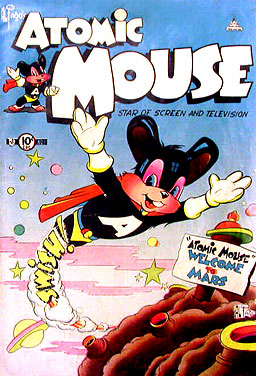
Atomic Mouse is a talking animal superhero created in 1953 by Al Fago for Charlton Comics.
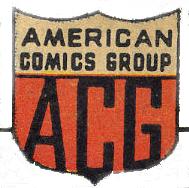
American Comics Group (ACG) was an American comic book publisher started in 1939 and existing under the ACG name from 1943 to 1967. It published the medium's first ongoing horror-comics title, Adventures into the Unknown. ACG's best-known character was the 1960s satirical-humor hero Herbie Popnecker, who starred for a time in Forbidden Worlds. Herbie would later get his own title and be turned into a "superhero" called the Fat Fury.
Daniel Campbell Gordon was an American storyboard artist and film director, best known for his work at Famous Studios and Hanna-Barbera Productions. Gordon was one of Famous' first directors. He wrote and directed several Popeye the Sailor and Superman cartoons. Later, at Hanna-Barbera, Gordon worked on several cartoons featuring Yogi Bear, Huckleberry Hound, and others. His younger brother, George Gordon, also worked for Hanna-Barbera.
Richard E. Hughes (1909–1974) was an American writer and editor of comic books. He was editor of the American Comics Group through the company's entire existence from 1943 to 1967, and wrote most of that publisher's stories from 1957 to 1967 under a variety of pseudonyms. His best-known character is Herbie Popnecker, created under the pseudonym Shane O'Shea, with artist Ogden Whitney.
Notable events of 1944 in comics. See also List of years in comics.
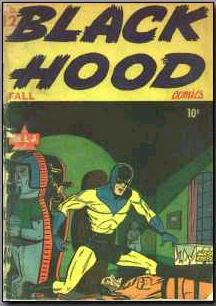
Black Hood Comics was the name of an American anthology comic book series published by MLJ Magazines Inc., more commonly known as MLJ Comics, for eleven issues between Winter 1943 and Summer 1946. The series featured MLJs costumed hero Black Hood, and "Boy Buddies", featuring Shield's partner 'Dusty the Boy Detective' and Wizard's side-kick 'Roy the Superboy', together with humor strips.
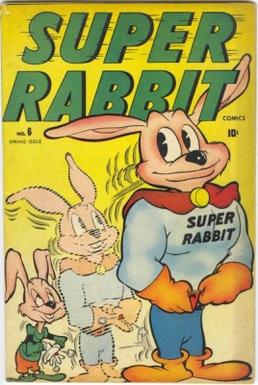
Super Rabbit is a fictional, talking animal superhero in comic books published by Timely Comics, a predecessor of Marvel Comics, during the 1930s and 1940s period fans and historians call the Golden Age of comic books. Created by cartoonist Ernie Hart, he first appeared in Comedy Comics #14.

Adventures Into the Unknown was an American comic-book magazine series best known as the medium's first ongoing horror-comics title. Published by the American Comics Group, initially under the imprint B&I Publishing, it ran 174 issues.

Jackpot Comics was the name of an American anthology comic book magazine series published by MLJ Magazines Inc., more commonly known as MLJ Comics, for nine issues between Spring 1941 and Spring 1943. It featured new stories of a number of characters previously seen in other MLJ publications.
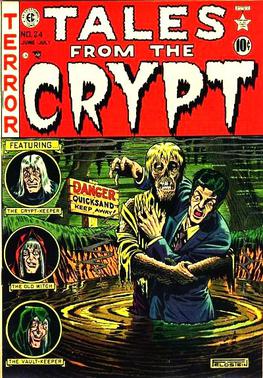
Horror comics are comic books, graphic novels, black-and-white comics magazines, and manga focusing on horror fiction. In the US market, horror comic books reached a peak in the late 1940s through the mid-1950s, when concern over content and the imposition of the self-censorship Comics Code Authority contributed to the demise of many titles and the toning down of others. Black-and-white horror-comics magazines, which did not fall under the Code, flourished from the mid-1960s through the early 1980s from a variety of publishers. Mainstream American color comic books experienced a horror resurgence in the 1970s, following a loosening of the Code. While the genre has had greater and lesser periods of popularity, it occupies a firm niche in comics as of the 2010s.
Toby Press was an American comic-book company that published from 1949 to 1955. Founded by Elliott Caplin, brother of cartoonist Al Capp and himself an established comic strip writer, the company published reprints of Capp's Li'l Abner strip; licensed-character comics starring such film and animated cartoon properties as John Wayne and Felix the Cat; and original conceptions, including romance, war, Western, and adventure comics. Some of its comics were published under the imprint Minoan. Some covers bore the logo ANC, standing for American News Company, at the time the country's largest newsstand distributor.

Shield–Wizard Comics was the name of an American comic book series published by MLJ Magazines Inc., more commonly known as MLJ Comics, for thirteen issues between Summer 1940 and Winter 1944.

Zip Comics was the name of an American anthology comic book series published by MLJ Magazines Inc., more commonly known as MLJ Comics, for 47 issues between February 1940 and Summer 1944. It featured a number of adventure, humor and costumed hero stories throughout the series, including the first appearance of superhero "Steel Sterling" and the earliest appearances of the humor strip Wilbur, who later had his own long-running series for Archie Comics.

Hangman Comics was the name of an American anthology comic book series published by MLJ Magazines Inc., more commonly known as MLJ Comics, for seven issues between Spring 1942 and Fall 1943. It featured MLJs costumed vigilante The Hangman, and "Boy Buddies", featuring Shield's partner 'Dusty the Boy Detective' and Wizard's side-kick 'Roy the Superboy', throughout the series.

Teen humor comics are a genre of comics that humorously depict contemporary American teenagers. When teen culture and buying power emerged in the early 1940s, comics publishers were quick to glut the newsstands with light-hearted, innocuous comic books about funny teens, cars, dating, high school, and parents. Teen humor comics appealed especially to young teen girls and tweens of both sexes because the books gave them a glimpse of what awaited them in high school.
Superkatt is an American cartoon animal comic book series by Dan Gordon, a jab at the “long-underwear” genre of superhero comics. The series stars Superkatt, an anthropomorphic cat who wears a bowtie, bonnet, and diaper as a superhero costume. Ron Goulart, author of Ron Goulart's Great History of Comic Books, said that Superkatt was Dang's most memorable comic book character. Denis Gifford, author of The International Book of Comics, said that the character "was as silly as his supercostume."
Farrell Publications is the name of a series of American comic book publishing companies founded and operated by Robert W. Farrell in the 1940s and 1950s, including Elliot Publishing Company, Farrell Comic Group, and Excellent Publications. Farrell is particularly known for its pre-Comics Code horror comics, mostly produced by the S. M. Iger Studio. Farrell also published romance, Western, adventure, superhero, and talking animal comics. Farrell acted as editor throughout. In addition to packaging art for Farrell from the beginning, Jerry Iger was the company's art director from 1955–1957.
Benjamin William Sangor was an American publisher best known for the 1940s to 1950s comic book company American Comics Group and for operating one of the earliest studios of comic-book writers and artists packaging comics for publishers entering the fledgling medium. He additionally was a real-estate entrepreneur.
References
- ↑ Wright, Nicky. The Classic Era of American Comics. Contemporary Books, 2000. "121. Retrieved on January 23, 2011. ISBN 0-8092-9966-6, ISBN 978-0-8092-9966-9.
- ↑ Overstreet, Robert M. The Official Overstreet Comic Book Pricing Guide. Random House, Incorporated, 1988. 45. Retrieved on January 23, 2011. "GIGGLE COMICS No. 1 (10/43, ACG, F)—Ties as first title of a new publisher, reinforcing the trend to funny animals. The quality and style of ACG's whole line was heavily influenced by the mastery of the[...]" ISBN 0-87637-761-4, ISBN 978-0-87637-761-1.